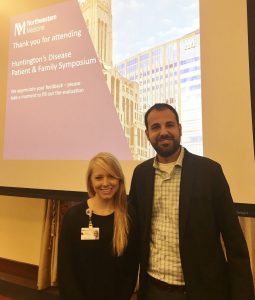Could Telemedicine Improve Quality of Care for Huntington’s Patients?
Written by |

My wife, Jill, excels at many things. She’s an excellent cook, gift giver, and advice dispenser. She also excels in her dislike of visiting a doctor’s office. As I’ve written before, she has “white coat syndrome.” But we have received some potentially awesome news that might ease some of her stress in that area.
Recently, I got an email blast from Emily Zivin, a social worker associated with the Northwestern University Feinberg School of Medicine in Chicago, in which she mentioned that Dr. Danielle Larson, the Movement Disorders Fellow at Northwestern, and Dr. Danny Bega, a neurologist who specializes in movement disorders, had been granted funding from the Huntington’s Disease Society of America (HDSA) to begin a research study called TeleHD.
This study, scheduled to start in the spring, will focus on telemedicine visits for Huntington’s disease patients as part of their clinical care. It will examine whether clinical visits for Huntington’s patients can be carried out via video camera. It will also explore whether this type of visit decreases the burdens of time and cost and whether patients and their care partners are satisfied with this approach.
When I told my wife about this study, she did three cartwheels and a backflip. (I’m speaking figuratively, of course.) She requested that I call and sign her up for it. I immediately complied. I also interviewed Larson and Bega to find out more about the study.
As most people know, video conferencing is often used in the business world. But in the medical field, it’s a little trickier. Doctors often need to carry out a physical examination of their patients. For someone with Huntington’s, this could involve assessing muscle rigidity, for instance.
However, we live in a big country, and, according to the HDSA, there are currently only 47 Centers of Excellence across the United States. This means it might take some patients several hours to drive to see a doctor at a center. Or, in the case of my wife, it may cause extreme anxiety to know that a doctor’s appointment is coming up, which, combined with the actual visit, may cause even more anxiety. Jill also has sensory issues, so being touched by someone is the equivalent of what people might experience when they are being waterboarded.
At Northwestern, an HDSA center of excellence, Larson said doctors believe televisits can be used to assess the motor and nonmotor symptoms of Huntington’s as effectively as in-person clinic visits. They also believe that Huntington’s patients and their families would prefer to have some doctor’s visits conducted remotely to save time and decrease travel-related cost and stress.
The study will evaluate 40 patients who receive care at Northwestern University’s HDSA Center of Excellence, with each person completing two regular in-person clinic visits and two televisits. The two types of visits will be compared to see whether Huntington’s symptoms are assessed similarly and accurately.
Larson said the patients and their caregivers would report their level of satisfaction, along with their preference for an in-person or televisit. The results would inform neurologists and Huntington’s medical care providers if telemedicine could improve quality of care for patients.
“I’m excited by the study,” said Larson, who’s seen how televisits help patients with Parkinson’s. “I’ve seen people [with Parkinson’s] in their homes. I’ve seen people at their offices. … Seeing them in their personal environments, it’s different. You can tell they’re more relaxed. They’re more comfortable. You get a better sense of how they’re doing. I had an interesting experience [with] one Parkinson’s patient, we actually did a four-way video conference with his family members, who otherwise wouldn’t have been able to make it to an in-clinic visit.”
Bega views the televisits as a win-win proposition. Patients who don’t live near a center of excellence will be able to receive more frequent expert care. And if the study shows televisits are viable, then it will potentially have a positive impact on research.
“We do not want to exhaust our research participants by bringing them in so often for visits if we can do some visits remotely,” Bega said. “If we can prove that the visits are accurate remotely, and potentially avoid having to bring patients as often to study how they’re progressing, that could really help us conduct research more effectively and more efficiently.”
My wife is looking forward to being part of the study. Stay tuned for more news on this in the spring.
***
Note: Huntington’s Disease News is strictly a news and information website about the disease. It does not provide medical advice, diagnosis, or treatment. This content is not intended to be a substitute for professional medical advice, diagnosis, or treatment. Always seek the advice of your physician or other qualified health provider with any questions you may have regarding a medical condition. Never disregard professional medical advice or delay in seeking it because of something you have read on this website. The opinions expressed in this column are not those of Huntington’s Disease News or its parent company, Bionews Services, and are intended to spark discussion about issues pertaining to Huntington’s disease.







Leave a comment
Fill in the required fields to post. Your email address will not be published.